
The Marin-Hassett House is located at 97 St. George Street in St. Augustine, Florida. It is reconstructed on its foundations that date to St. Augustine's First Spanish Period.

The Marin-Hassett House is located at 97 St. George Street in St. Augustine, Florida. It is reconstructed on its foundations that date to St. Augustine's First Spanish Period.
There was a one-story house that stood at this site during St. Augustine's First Spanish Period (1565-1763). During the 19th century a second floor and a wooden rear wing was added. The house is mainly made of coquina and sealed with plaster. It is next to the Hispanic Garden, a replica of a formal Spanish garden, containing a bronze statue of Queen Isabella sculpted by Anna Hyatt Huntington. [1]
The original stone house belonged to Antonia Marin. During Florida's British Period, James Box bought the house, and then a Stephen Haven bought the house. During the Second Spanish Period, in 1787, Father Thomas Hassett bought the property. Hassett was an Irish priest who served the Minorcan community of St. Augustine and established the first free school in what would become the United States. [2]
Senator George Smathers was Chairman of the Subcommittee on Latin American Affairs of John F. Kennedy's President’s Quadricentennial Commission. On behalf of that President’s Commission, he invited the Pan American Union to take part in the restoration project occurring in downtown St. Augustine in the 1960s. The goal was to have representatives from Latin American countries arrange cultural exchanges, exhibits, and musical performances for the St. Augustine’s quadricentennial in 1965. President Kennedy likened this project to the building of Colonial Williamsburg in Williamsburg, Virginia and was quoted as saying, “I can see how valuable it will be to have a similar symbol of the cultural heritage which came to us from Hispanic-American sources. This can be a most important new symbolic bond with our Latin-American neighbors to the south (as well as to Spain across the ocean.” [3]
St. Augustine Restoration Inc. bought the property (formerly housing the Manufacturer's Outlet Store and St. George Tavern) and reconstructed the Marin-Hassett House using funds donated by American corporations that had done business in Latin America, such as Ford, General Motors, Texaco, and Gulf. [4] It took $25,000 to purchase the land and $27,066 to build the center. [5]
Earle Newton, Director-General of the Quadricentennial Commission in St. Augustine, served as the first curator of the Pan American Center. [6] Dr. Carlton Calkin then served as curator. The center housed art exhibits of hispanic origin. The Pan-American Center was to complement the nearby Spanish government cultural and exhibition center, as well as expected U.S. government, State of Florida, and British government centers. [3]
On April 24, 1965 representatives of several nations of the Organization of American States participating in a cornerstone ceremony for the Center. Representatives included those from Argentina, Brazil, Colombia, Costa Rica, the Dominican Republic, Ecuador, Paraguay, Guatemala, Peru, Panama, Honduras, and the United States. [7]
Statutes on display included, especially during the Christmas season, religion icons from the 17th-19th centuries from Mexico, Ecuador, Peru, and Guatemala. The Center had a three-foot statue of Saint Augustine. Most statues were painted and covered with gesso, a mixture of plaster and glue. [8] In January 1968, the Pan American Center displayed a replica of a mummy found along the south coast of Peru in a Paracas Tomb as part of its Pre-Columbian exhibit. [9] Most objects continuously displayed in the Pan American Center came from tombs (pottery, gold jewelry, sculpture, or textiles). The oldest artifact in the collection, however, was a netted textile from 600 B.C.E. Peru. [10]
In the late 18th century Father Hassett grew a vegetable plot and orchard on the land to the south of the house. In the mid-20th century this same space was converted from an Appliance Center and used as a garden again, linked the building to the Spanish Exhibition Center across the street. The garden was made possible by a donation of Jessie Ball duPont, supplemented by contributions from garden clubs and other organizations. [11] The landscaping was accomplished by the Women’s Garden Clubs of Florida.
Today the downstairs of the Marin-Hassett House is retail space operated by dog store Faux Paws. The upstairs of the house is St. Augustine Foundation Inc. The entire building is owned by St. Augustine Foundation, Inc.
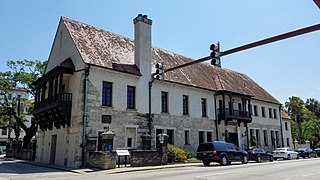
Government House, also known as Governor's House, is located at 48 King Street in St. Augustine, Florida, adjacent to the Plaza de la Constitución. The building, constructed of coquina, served as the governor's official residence from c. 1710 during the First Spanish Period (1565–1763), throughout the British Period (1763–1784), and until 1812 in the Second Spanish Period (1784–1821). Governor Gonzalo Méndez de Canzo was the first governor to build his residence on the present Government House site in 1598.
The St. Augustine Historical Society (SAHS) is a membership organization committed to the preservation and interpretation of historically significant structures, artifacts, and documentary materials related to St. Augustine, Florida. Formally organized on New Years Day 1883, SAHS is the oldest continuously operating museum and historical society in Florida. In 1899, the society purchased the Vedder Museum on Bay Street where it exhibited historical and scientific curiosities until losing its holdings in the Saint Augustine Fire of 1914. In 1920, SAHS successfully lobbied for federal restoration of Fort Matanzas, and in 1965, it played a significant role in the restoration of numerous historic sites in preparation for the St. Augustine quadricentennial.

The Triay House is a historic property located at 31 St. George Street in St. Augustine, Florida. It is a reconstruction of the First Spanish Period structure that stood on the site.

The Sánchez de Ortigosa House is located at 60 St. George Street, St. Augustine, Florida. It is a reconstruction of a home dating from the First Spanish Period (1565-1763) that stood on this site.
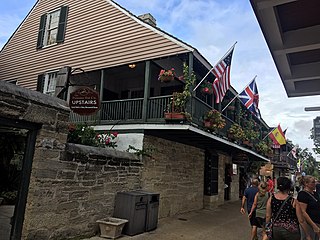
The Arrivas House is located at 46 St. George Street, St. Augustine, Florida. It was the first completed restoration project of the Historic St. Augustine Preservation Board (HSAPB), and was named after early owner Don Raimundo de Arrivas.

The Cerveau House is located at 26 Cuna Street in St. Augustine, Florida. It is an original house, constructed in the 19th century.

The Florida Heritage House is located at 1 Aviles Street, or 11 King Street, in St. Augustine, Florida. It is a reconstruction of a late Spanish colonial-style house built in the 19th century.
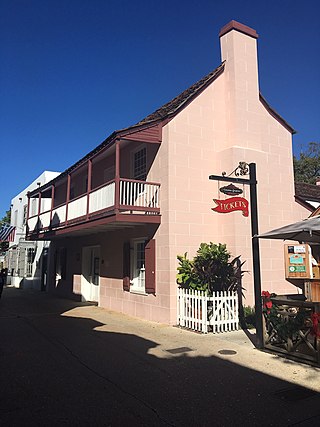
The De Mesa-Sánchez House is located at 23 St. George Street in St. Augustine, Florida. It is a restoration of a home dating back to East Florida's First Spanish Period.
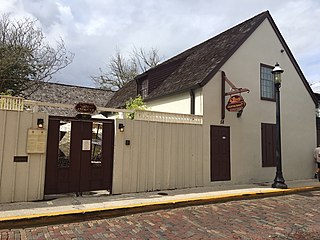
The Luciano de Herrera House is located at 58 Charlotte Street in St. Augustine, Florida. It is a reconstruction, depicting a house from St. Augustine's Second Spanish Period (1784–1821).

The Ortega House is located at 70 St. George Street in St. Augustine, Florida. It is a reconstructed home representing the architectural style of the First Spanish Period (1565-1763) in Florida.

The Joaneda House is located at 57 Treasury Street in St. Augustine, Florida. It was restored to be an example of a Second Spanish Period (1784-1821) residence. It is one of the oldest buildings in Florida.
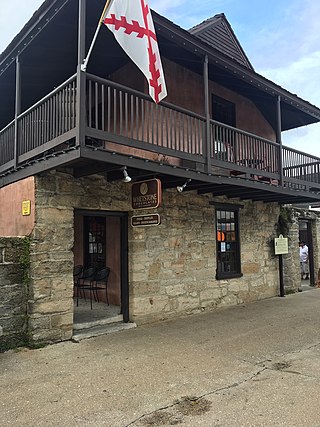
The Salcedo House and Kitchen are located at 42 and 42 1/2 St. George Street, in St. Augustine, Florida. They are reconstructions of 18th century structures that stood on these sites in St. Augustine's First Spanish Period (1565–1763).

The Pellicer-De Burgo House is located at 53 St. George Street in St. Augustine, Florida. It is a reconstruction of two connected houses built during the British Period (1763-1783) of East Florida.
Earle W. Newton, II (1917–2006) was a historian, preservationist, publisher, educator, and art benefactor.
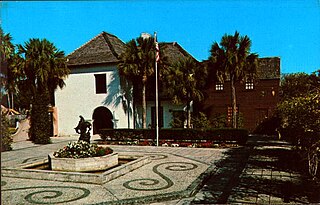
The Hispanic Plaza is a garden in St. Augustine, Florida owned and maintained by the St. Augustine Foundation, Inc. It is closed to the public and is only opened for special city events.
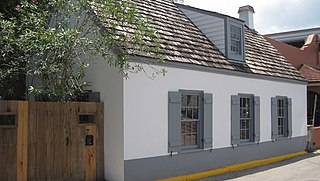
Elizabeth Towers (1899–1985) was an American philanthropist and socialite known for her dedication to historic preservation in northeast Florida.
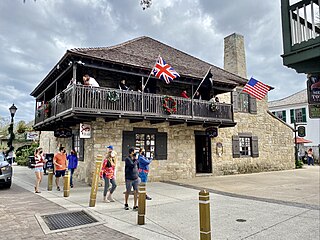
The Casa del Hidalgo is located at 35 Hypolita Street, at the southeast intersection of Hypolita and St. George Streets in downtown St. Augustine, Florida. It was constructed in 1965 and housed the Spanish government's official exhibition and cultural center.

The Paredes-Dodge House is located at 54 St. George Street in St. Augustine, Florida. The one and a half story structure was built between 1803 and 1813, and is one of the only surviving colonial structures in St. Augustine.

The Segui-Kirby Smith House is a historic house at 12 Aviles Street in St. Augustine, Florida. Built in the late 1770s, it was the childhood home of Confederate States Army General Edmund Kirby Smith (1824–1893), the commanding general of the Trans-Mississippi Department from 1863 to 1865 and the chancellor of the University of Nashville from 1870 to 1875. It is owned and operated by the St. Augustine Historical Society and is home to the St. Augustine Historical Society Research Library.
Juan José Eligio de la Puente y Regidor (1724–1781) was a Spanish Floridian (Floridano) who held various public offices in St. Augustine, Florida and in Havana, Cuba, during the 18th century. He served as chief officer of the Real Contaduría for Spanish Florida, and as principal auditor for the Tribunal de Cuentas in Havana, offices that managed the colonial governments' accounts and expenditures. Puente was a member of St. Augustine's 18th century elite Criollo community, and had a role in many events of that period in the history of Florida. He acquired considerable wealth, became a royal treasury official in Cuba, and influenced Spanish foreign policy in North America.